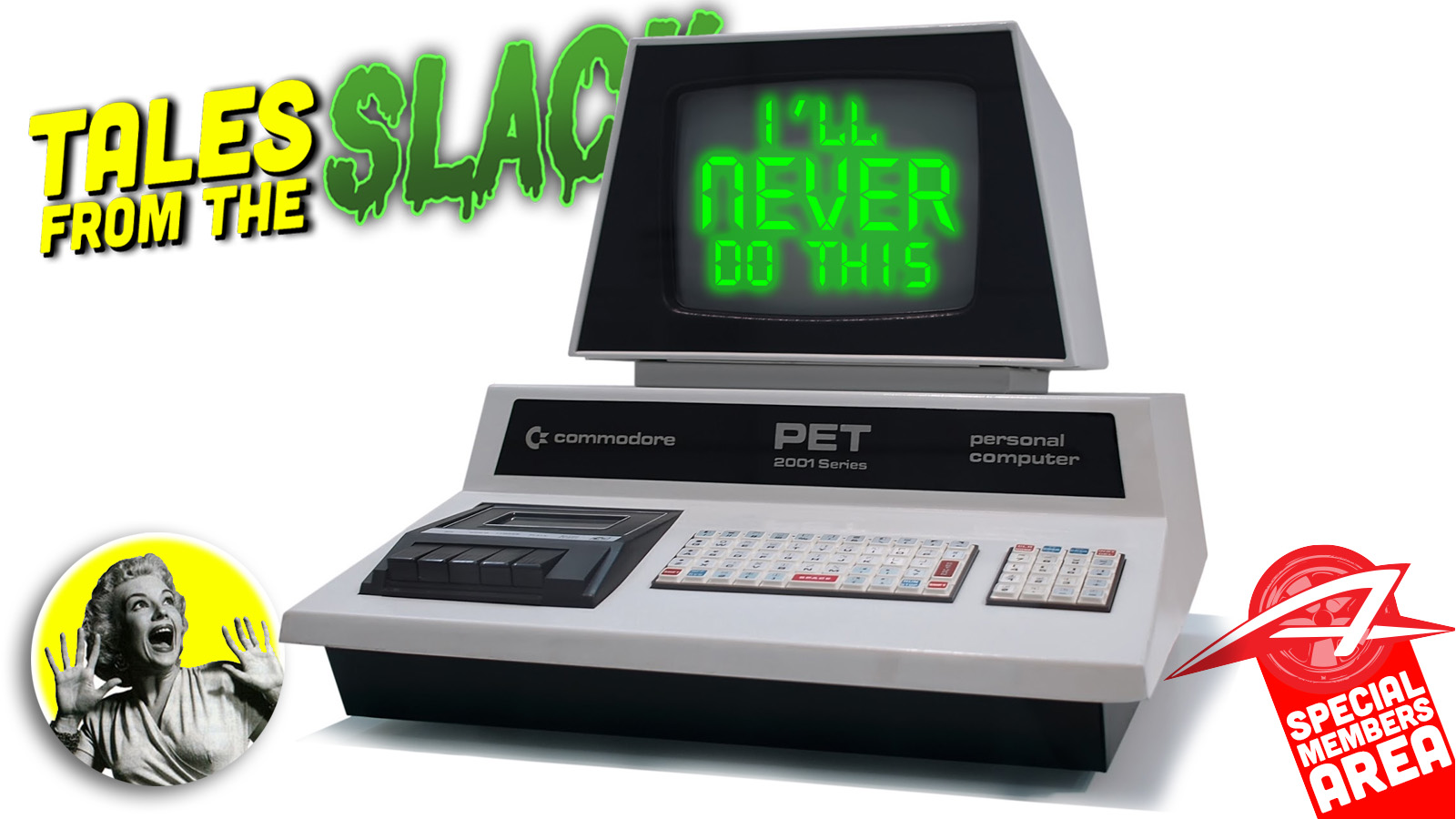I’ve slowly realized some traits about myself that are kinda, well, stupid. One of the big ones is that I find I’m far too willing to adapt to certain discomforts and inconveniences instead of actually, you know, solving a problem, and this bites me on the ass. Often a lot of biting. In fact, when it comes to this issue with my ’89 Ford F-150, my ass has been bitten so much it’s like my ass is part of the buffet at some sort of underwater Sizzler that caters to the shark community. And I think I’ve finally realized I just need to fix the damn thing.
The thing I need to fix is a deceptively tiny thing, just five broken teeth on the 164-tooth flywheel. When I think about it, I reason that hey, the flywheel still has 96.9512195% of its teeth! How big a deal can this, be, really? The odds of the starter meshing with the part of the flywheel missing teeth is be a tiny probability, right? How bad could it be?
Well, the truth is that it actually can be pretty bad! Even though it’s just five teeth, I was delusional to think that that means that there would be a tiny chance of the starter ending up away from that small gap of broken teeth, because engines don’t really work that way.

No, it’s not just about where the flywheel will end up in relation to the starter once I shut the engine. Because the engine has to cycle — compression and power and intake, and, yes, exhaust — it has to “spin over” to start, which means those five teeth actually have a fairly high chance of ending up right in line with the starter pinion, with which they cannot and will not mesh. It all depends on where in the cycle everything starts, and if the engine can build enough momentum to fire by the time those five teeth come around. Often times it doesn’t go well.
Really, it seems like this is the case most of the time, because even though I’ll try turning the key in an act of unbridled, unbent optimism, most of the time I’m just greeted with mocking whirring sound as the starter gear spins freely, unbothered by meshing with teeth that turn a whole 300 cubic-inch engine.

So, that means what I have to do is put it in neutral, jam that parking brake down nice and hard and say a little bracha just to be safe, take that big socket wrench I keep in the cab [Ed Note: I donated Jason that wrench partly out of pity. -DT], roll under the truck, get the socket on the crankshaft pulley bolt, and crank the engine over a few times to hopefully get the starter gear in place to mesh with some teeth on the ring gear.
This process, as you can maybe imagine, kind of sucks: if it’s wet – which it has been here a lot lately — you get all moist laying on the ground, it gets my arm all greasy, and often I scrape my knuckles against the fan blades. Then, I roll out, get back in the car, turn the key and hope. I feel like when I started doing this, it would go pretty quick, but lately I feel like I have to roll under the truck and crank that engine three, four, five, or more times before it’ll actually get the starter meshed and turn that engine over.
Why? Why is it like that? Am I not cranking it over enough times? I feel like I am – I can feel the compression of the engine at various cycles, and one time it even kicked back, which hurt. [Ed Note: Jason do not do this with the key in the ignition! -DT].

Anyway, the point is, I’ve been living with it like this for quite a while now. And I have been using the truck for things! I took it to Charlotte for an Ikea run, I helped with a move, I did dirty things to help neighbors, dump runs, all the usual truck stuff. And, for the most part, this is the sort of thing where I can roll under it to turn it on once, and just not turn it off as long as I’m using it.
But sometimes you need to turn a truck off! Sometimes it has to be parked or sometimes it’ll stall just because the universe doesn’t want to make things too easy for you or whatever! And then, that’s when it gets shitty. For example, this past weekend I took a trip down to Wilmington to pick up all those Citroën 2CV parts and I went with a friend, and that makes a difference, because having someone who is not you witness the absurd hassles you put yourself through to, say, start a truck, that delivers some much-needed perspective.
This friend was remarkably patient with it all, but I could tell that the struggles to start the truck were not, um, endearing, let’s say. It happened a few times – a stall as we were just heading off, another starting ordeal after getting gas, and then came the worst one: The Getting Coffee Ordeal.
The Getting Coffee Ordeal
My friend wanted some coffee as we arrived in Wilmington, which seemed fine by me – we even found a drive-thru coffee place just to avoid the hassle of having to park the truck and turn it off. It was a great idea! But holy crap did it go wrong.
Right as I turned into the drive-through lane, the truck stalled. My heart sank as I tried the key and heard the grimly-expected whirr. I grabbed the wrench and rolled under the truck to crank it over, got back in to try the key, and repeated this far too many times, to no avail.

Then the owner of the coffee shop came out to remind me of an obvious, glaring truth: I was blocking her drive through. People were driving by and glaring at me. I was impeding the commerce of a locally-owned coffee shop all because I was too big of an idiot to just fix my damn truck. I went back under. I tried the key. I went under again, key again, under again – no avail. My friend went in to get coffee, came back out to find me still at it. A bit of panic was setting in.
What if my compiled roster of sins and failings had all come due, and this was now my fate? What if I was doomed to do this forever, like Sisyphus and his rock, but instead it’s me, blocking a drive through, desperately trying to start a truck?
Eventually, thankfully, something took pity on me and the teeth meshed and the truck started. I got the hell out of there as quickly as possible, but now the specter of a stall or any hiccup lingered over my head, like a big oily sword of Damocles, waiting to ruin my day. I made it to Stephen’s place, where I did have one more session of below-truck cranking, but then I just left the truck running while I loaded the parts and made it back home, all without turning the truck off once.

I made it back, everything was fine, but I think I finally learned my lesson: sometimes, adaptability is a curse. Yes, I can usually deal with an inconvenience with a car’s operation, I can get used to doing some awkward little trick to make something basic happen, but what we’re willing to tolerate can often snowball, and before you know it you’re on your back cranking an engine by hand, over and over, every time you want to start your truck. And that’s absurd.
This won’t be that big a deal to actually fix. I’m just going to finally do it, and then when the decadent luxury of a truck that starts with a key, like a 1979 Rolls-Fucking-Royce, finally hits me, I’m going to remember that this is simply how it should always have been. I shouldn’t have been willing to accept, for so damn long, something so absurdly sub-par. Why do I do this to myself? And, not just to myself, as I learned what seems like just a little whatever I can deal with soon becomes a big whatever for whomever is unfortunate enough to have to deal with me and this problem.
So, friends, please, take it from me: if there’s an annoying little thing on your car that you’re just sort of working around, take a moment to step back and think about what you may be doing. Even if you’re used to it, and it’s not even something you think about anymore, is it actually a big deal? Ask someone who isn’t you. See what they’re willing to endure. And then maybe rethink things.
Don’t end up like me, friends. I really better fix this stupid thing this time.







Missing 5 teeth? May need to make a dentist appointment for…(cue DT’s joke) 2:30…because your tooth hurty
Nu? Which bracha did you say? Gevalt, maybe it was the wrong one?